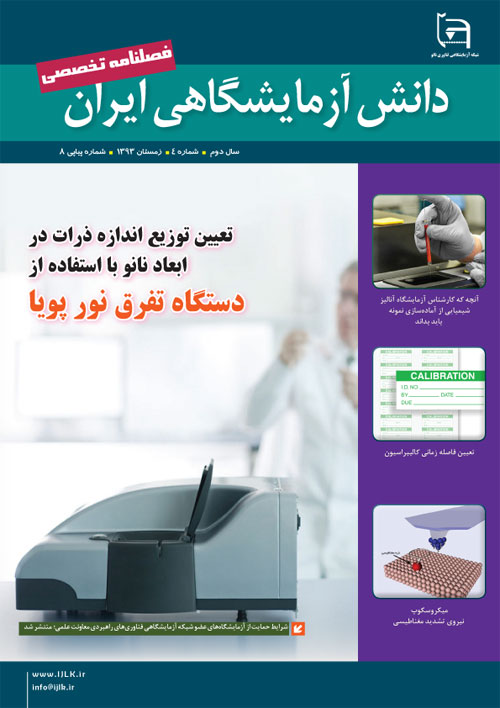فهرست مطالب

مجله دانش آزمایشگاهی ایران
سال دوم شماره 4 (پیاپی 8، زمستان 1393)
- 38 صفحه،
- تاریخ انتشار: 1393/12/20
- تعداد عناوین: 7
- اخبار
- استاندارد
- مقالات
-
صفحه 21
-
صفحه 30
-
Page 4
This paper reviews how to prepare liquid and solid samples for readings by atomic absorption device and ICP. As you know, preparation of samples for chemical analysis includes important and crucial parts. in Chemical analysis to determine the amounts of elements, whether in the classical methods such as titration (volume measurement), gravimetric and visible light and ultraviolet spectroscopy or the newer methods such as atomic absorption spectrometry and atomic emission spectrometry inductively coupled plasma environment, the sample should be fully dissolved. The methods in use with regard to the type of sample soil, sediment, living tissue, plant, and etc, will vary with each other and with respect to reagents and chemicals used and the tools needed should be affordable. Since our goal is sample elemental analysis, therefore the methods in use should act the way that the main characteristics of the samples do not change and all elements of samples should remaining environment. In most of such methods usually inorganic acids or a suitable mixture of them with oxidizers, alkaline solutions, or in the case of some resistant elements, alkaline melts in the presence of appropriate melting aids are used. In fact, in normal conditions, sample preparation take approximately 60% of the total time of analysis. Therefore such matters play an important role in the accuracy of the analysis, in particular with Trace elements. In the case of samples containing refractory elements such as aluminum, silicon, zirconium, beryllium, thallium, lanthanum and thorium, due to high chemical resistance, their preparation in terms of type and quantity of chemical agents or the duration of the process digestion, many problems will lead in to many difficulties.
Keywords: Digest Acid, Microwave, Atomic Emission, Atomic Absorption, Sample Preparation -
Page 9
To ensure the quality of a product, tools shall be precise and accurate, so calibration of measurement tools is necessary. The quality of devices results is depending on periodic and accurate calibration. We can follow metrology specifications by calibration and we can do appropriate modifications, as necessary. In technical requirements section of quality management standards, devices calibration is important and necessary. In industry in order to control devices operation devices monitoring and measurement, determination of calibration program is necessary. The target of writing this article is determination of maximum real time interval between measurement equipment and standards consecutive confirmations. Determination of periodic calibration time intervals for measurement devices is the most effective item in calibration system.
Keywords: Calibration, Metrology Specifications, Periodic Calibration -
Page 14
Dynamic light scattering (DLS) is a technique in physics that can be used to determine the size distribution profile of small particles in suspension or polymers in solution. It is widely used as an effective technique for determining the average secondary particle size of Brownian nanoparticles in colloidal suspensions. In current study, the theory and mechanism behind DLS is discussed.
Keywords: Dynamic light scattering, DLS, Sizedistribution, Size determination -
Page 21
In nanotechnology and molecular biology, researchers are often severely limited by the inability to observe atoms and molecules in three dimensions. Magnetic resonance force microscopy (MRFM) is a kind of scanning probe microscopy which combines the three-dimensional imaging capabilities of magnetic resonance imaging (MRI) with the high sensitivity and resolution of atomic force microscopy (AFM). MRFM uses a micro magnet cantilever to detect the interaction force between a magnetic field gradient and a nucleus spins in a sample surface atoms.
Keywords: Magnetic resonance, Magnetic moment, Atomic force microscopy, Magnetic resonance force microscopy


